Pork cubes cooked in a salty, fragrant sauce, then served with noodles and various vegetables, Zha Jiang Mian is a signature Beijing dish full of flavour and freshness.
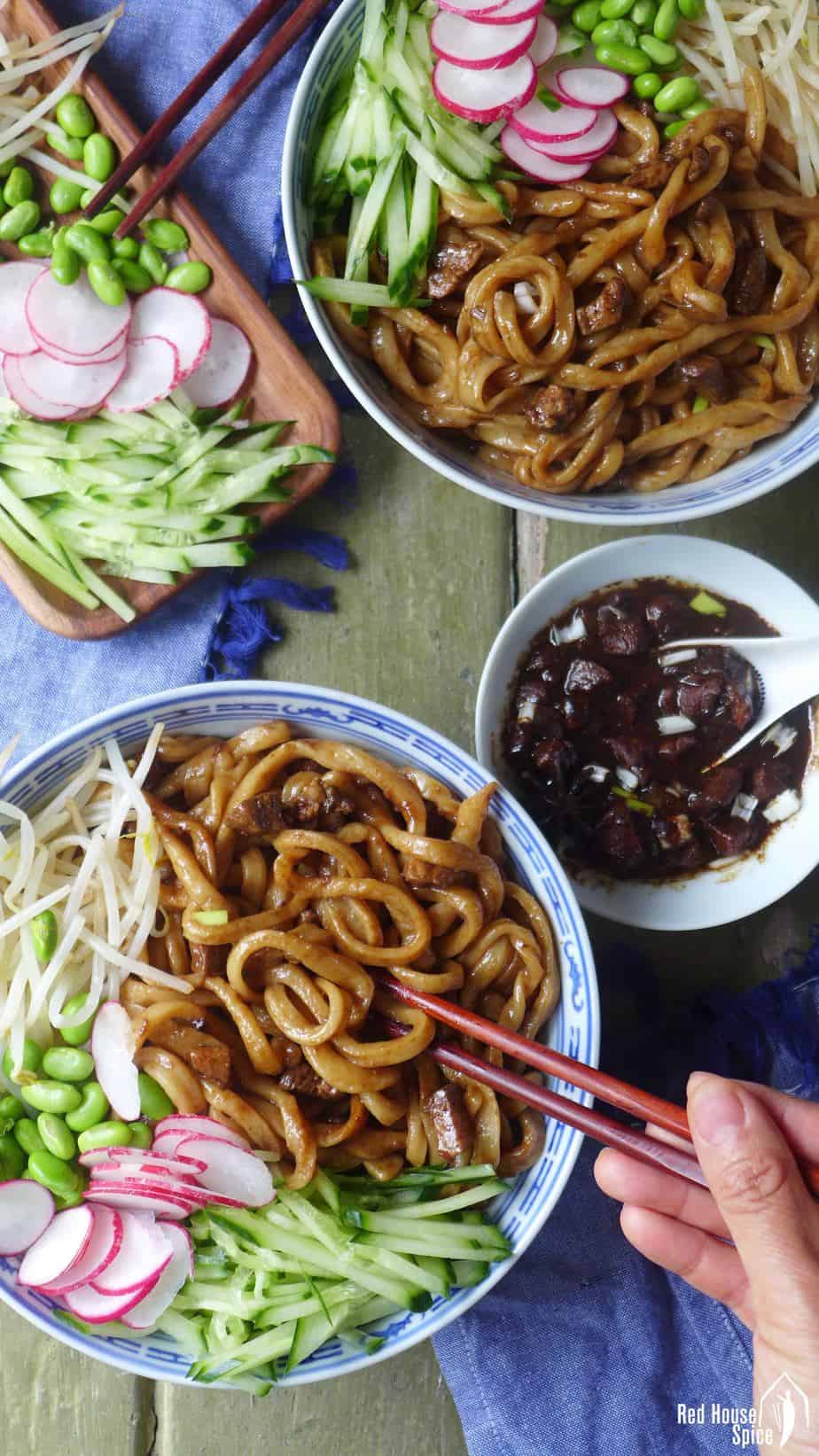
Before coming to Europe, I worked in Beijing for quite a few years and I consider it as my second home. In this vibrant city, you have the opportunity to explore amazing food from every corner of China (and increasingly more international cuisines too). However, traditional Beijing cuisine is always treasured by locals and migrants alike.
Apart from the famous Peking duck, I love its signature noodle dish Zha Jiang Mian (炸酱面) and often wandered around the back streets to look for humble little cafés which offer the most authentic versions of this dish.
The literal meaning of Zha Jiang Mian is fried sauce noodles. Popular in Northern regions of China, this dish consists of three components: pork fried then simmered in a dark, thick and salty sauce, freshly cooked noodles and various types of vegetable.
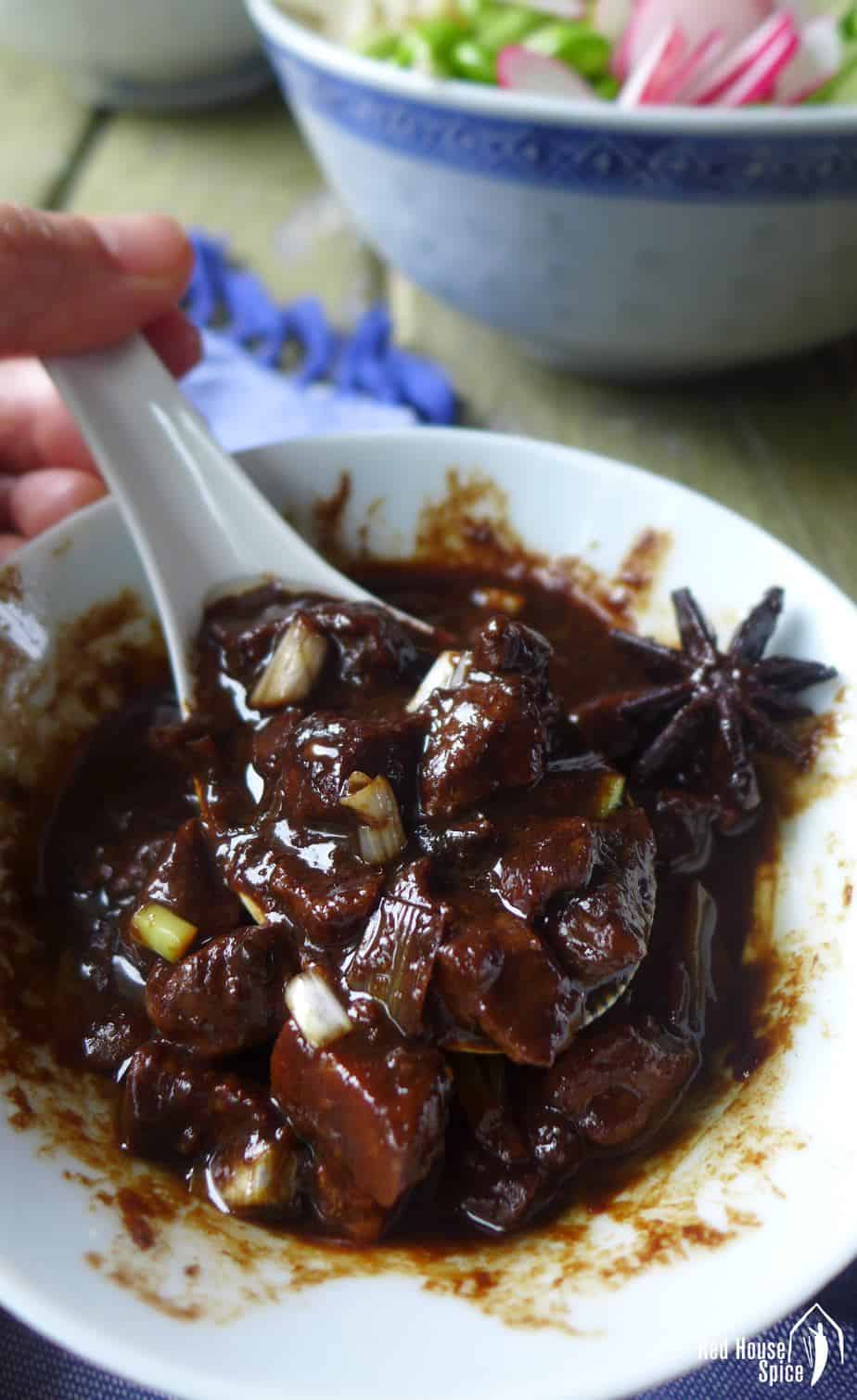
Among all the different versions of Zha Jiang Mian, I prefer the Beijing style in which yellow soybean paste is used as the main seasoning (sweet bean sauce, hoisin sauce or broad bean sauce are used in other versions).
Yellow soybean paste (黄豆酱) is a dark, thick paste made of fermented yellow soybeans, wheat, salt and water. Pungent, aromatic and salty, it’s the soul of Beijing Zha Jiang Mian. Yellow soybean paste comes in two forms: regular or dry. The latter contains less water, thus it has a pretty solid texture.
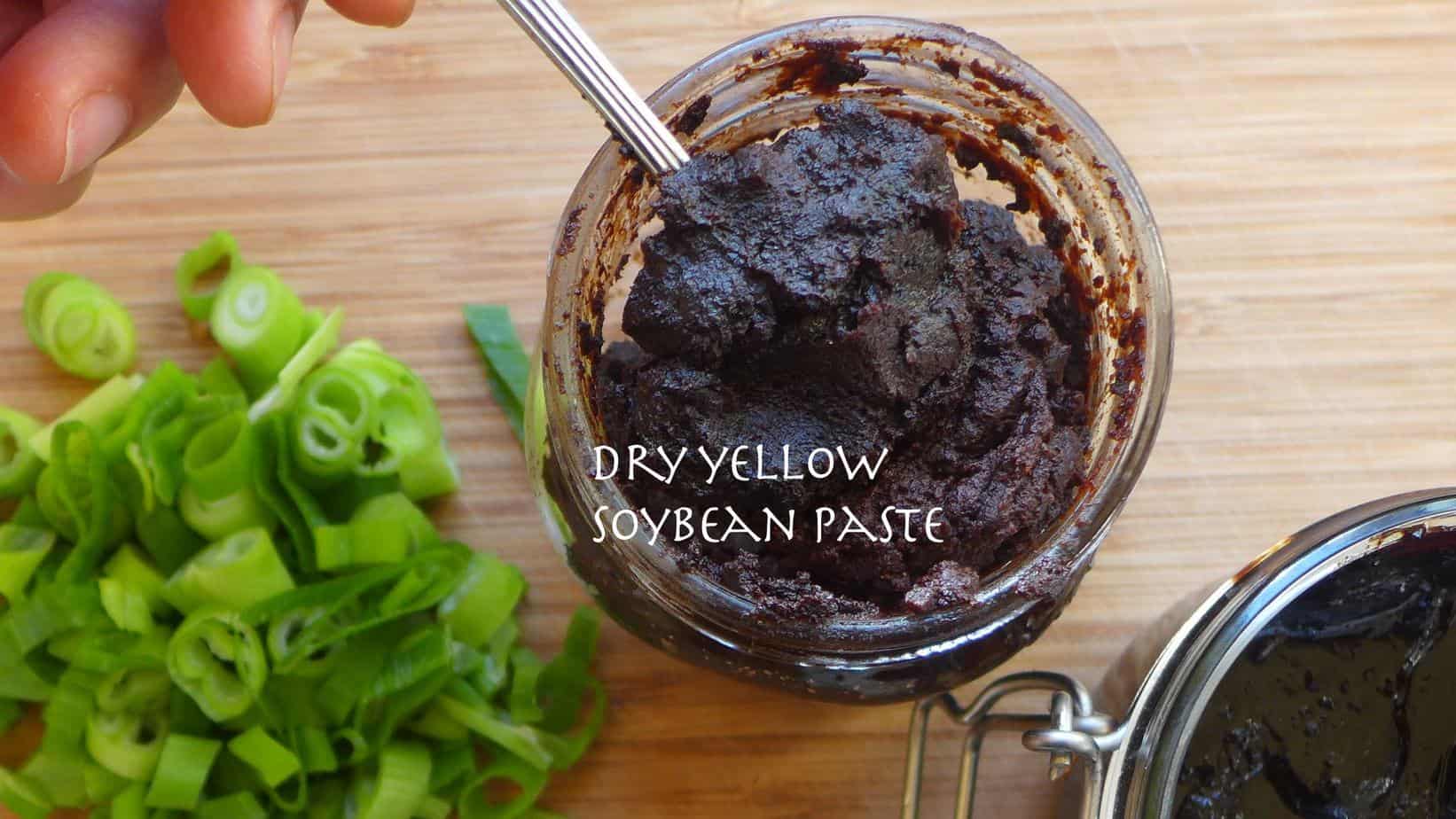
I use dry paste (干黄酱) in my recipe (see image above). Adjust the volume if you wish to use the regular one (about 1.5 times of dry paste diluted with the same amount of water). Yellow soybean paste is available in most Chinese / Asian grocery shops. I usually buy dry paste made by a reputable Beijing brand called “Wang Zhi He (王致和)”. In my recipe, a small amount of sweet bean sauce (or hoisin sauce) is added for a hint of sweetness.
Diced pork is used in classic Beijing Zha Jiang Mian (pork belly or other part that contains some fat). Its small size allows you to cook it in a short period of time, yet it still gives you a nice bite. I’ve seen many recipes call for minced pork. It wouldn’t be my first choice. But it does save me time when I’m in a hurry (no chopping).
Knowing the principle of this dish, you are free to be creative with the ingredients. Why not try beef, lamb or chicken if you don’t fancy pork? And making Zha Jiang Mian a vegetarian dish is possible too. Tofu (firm ones) and shiitake mushroom would be great options.
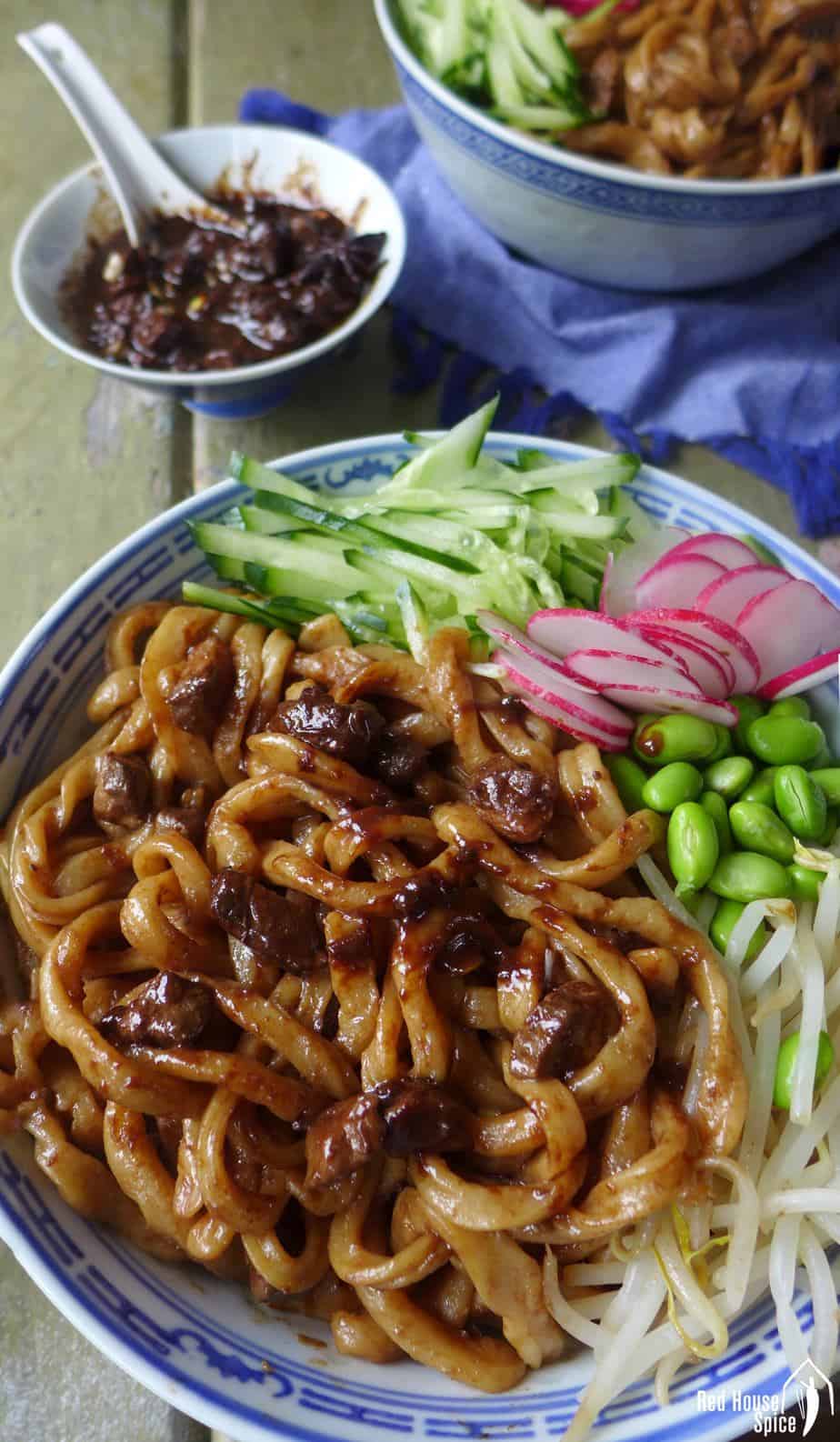
Vegetables play an important role in Zha Jiang Mian. They are served either raw or quickly blanched, preserving the most of the nutrition. Without any additional seasoning, the natural plain taste of vegetables go very well with the salty, aromatic sauce, giving this dish a good balance.
There are a wide range of vegetables that you can choose as topping: cucumber, beansprouts, radish, fresh green soybeans (aka edamame), Chinese cabbage, carrot, celery or any other vegetables with a crunchy texture.
Traditionally, Beijing cooks use homemade noodles in Zha Jiang Mian. Firm dough (made of plain flour, water and a pinch of salt) is rolled flat with a rolling pin, then cut into long, thick noodles. A pasta maker will be handy to achieve a similar result.
I usually make hand-pulled noodles (as shown in photos) for this dish which also has a thick look and a slightly chewy texture. Shop-bought dried noodles are fine too. They are time-saving and stress-free.


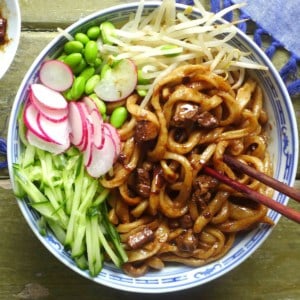
Zha Jiang Mian (炸酱面)
Ingredients
For the sauce:
- 4 tablespoon dry yellow soybean paste
- 1 tablespoon sweet bean sauce - or hoisin sauce
- 300 ml water - 1 ¼ cup
- 2 tablespoon cooking oil
- 1 star anise
- 2 stalk scallions - chopped
- 1 teaspoon ginger - minced
- 200 g pork, diced - 7oz (see note 1)
- 1 teaspoon Shaoxing rice wine
For the vegetables
- 150 g beansprouts - 5oz
- 150 g fresh green soybeans/edamame - 5oz
- 1 large cucumber - julienned
- 6 radish - sliced
For the noodles
- 4 servings fresh or dried noodles - see note 2
Instructions
- In a bowl, dilute dry yellow soybean paste and sweet bean sauce (or hoisin sauce) with water. Set aside.
- Heat up oil in a wok over medium-high heat. Add star anise, spring onion (the green part) and ginger. Leave to sizzle until fragrant. Stir in pork and rice wine. Cook until the pork becomes pale.
- Pour in the diluted sauce. Bring it to a boil then leave to simmer for 20 minutes.
- Then boil on full heat to thicken the sauce to the desired consistency. Stir in the white part of the scallions.
- Blanch beansprouts and green soybeans in boiling water (cucumber and radish are served raw). Take them out then drain.
- In the same pot, cook noodles. Drain and rinse under cold water for a few seconds.
- Place the noodles in 4 serving bowls. Top with the sauce and vegetables.
NOTES
NUTRITION
NUTRITION DISCLOSURE: Nutritional information on this website is provided as a courtesy to readers. It should be considered estimates. Please use your own brand nutritional values or your preferred nutrition calculator to double check against our estimates.


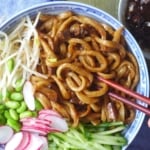
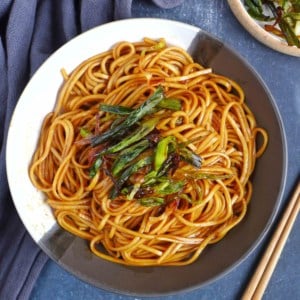


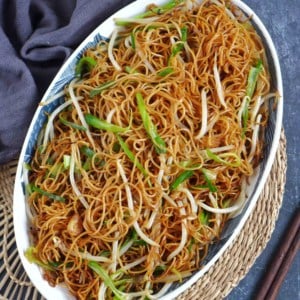
Hi Wei,
I have a potentially very silly question for you. My pantry contains a lot of asian foods and spices that i don’t use too often and i am trying to not buy more spices. I don’t have dry yellow bean paste but would really like to make a variation of this dish. Could i use Doubanjiang instead? And what other changes would i have to make to the ingredients? I understand that the dish will no longer be Zha jiang Mian but i am happy to settle with a tweaked version of it. Any tips on how to use Doubanjiang would be greatly appreciated! Thank you 🙂
Yes Razia, you can use Dougbanjiang as a substitute. The only thing you need to pay attention is the saltiness. You may need to adjust its quantity as needed. Happy cooking!
Thank you for your reply! Will try it out and let you know how it went 🙂
Wei, could you post a picture of the jar of the Wang Zhi He Yellow Bean paste? It would make it much easier to find at the local Chinese grocery store if I had a picture to reference. Thanks so much.
Hi Barry! I’ve emailed you a picture.
Thanks wei for the recipe.
Instructions were easy. I used miso, and hoisin sauce with a bit of sugar. My whole family said its delicious. As for me, i am more on no meat diet, so i used mushrooms, and dried beancurd.
Thank you for sharing your no meat twist of the dish.
Hi, how much water am I using to dilute the yellow bean paste please?
Also I bought the yellow bean paste accidentally, what other recipes can I use it for? Thank you
Use 300ml water as suggested in the recipe. You can use yellow bean paste as substitute for sweet bean sauce to make Peking Shredded Pork or Chongqing Noodles.
Hi Wei
Thank you for this recipe.
I have one question: would it be possible to use miso instead of the yellow soybean paste?
I’ve never tried with miso but I assume it works too. You might need to adjust the quantity as it has a different level of saltiness.
Hi Wei! I am really grateful to learn about Beijing’s Zha Jiang Mian. Its savory taste must come from Yellow Bean Paste, I guess. Once I had Zha Jiang Mian at a small tea house in Chongqing and cannot forget the genuine and honest taste of a somewhat rough and basic sauce (it was bean paste-based) . Could you please kindly comment on the difference between them? (i.e, yellow bean paste in Beijing’s zha jiang mian and bean paste in Chongqing’s zha jiang mian) With many compliments!
Thank you for trying out my recipe Jason! In fact, these two dishes have different names: the Beijing one is ZHA Jiang Mian (炸酱面) whereas the Chongqing one is ZA Jiang Mian (杂酱面). Their pronunciation is somehow similar but not exactly the same. For the latter, please check out my recipe for Chongqing Noodles. You’ll find out the ingredients involved are quite different. But both versions are delicious!
Aloha! Is this the origins of the Korean-ized Chinese dish called “Tangsuyuk”? The restaurants that serve this some are owned by Chinese who came from the border with Korea and some are Korean who also make what I think is the Korean version of Zha Jiang Mian (炸酱面) that they call “Jajangmyeon” which is a black Bean base they call chunjang vs. Gan huangjiang & Tianmianjiang in Hawaii hard to find these Beijing type sauces so sub huang doujiang and hoisin(recently found some tianmianjiang).? Just curious if you’ve tried these Korean takes on northern Chinese dishes?
Yes, I’ve had jajangmyeon (Korean black bean noodles) which is considered a dishinspired by Chinese Zha Jiang Mian. Very tasty too!
Where do you get dry yellow bean paste from? I’m in U.K. and only see yellow bean sauce/paste. If I get the sauce should I change the proportion?
Hi Marty! I’ve found dry yellow bean paste in a Chinese shop in Coventry long time ago. Yes, yellow bean sauce is more accessible and you can surely use it to substitute. As the saltiness of yellow bean paste varies depending on the brand, I suggest you use 4 tbsp at first. Taste a little after 15 mins of simmering. Add more if necessary. Hope this helps.
I used 5tblsp and it was a bit too salty but the flavor was good. Hardest part was doing the hand pulled noodles. It’s hard to pull enough at a time. I need some practice
Practice makes perfect. You’ll master it soon Marty!